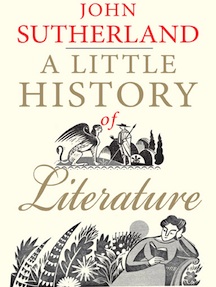By David Partenheimer
What should one read? Sutherland starts and ends his book with this question. Sutherland recommends a supermarket shopping cart strategy, in which one chooses from “the wealth of what is available by defining your own specific needs, interests and tastes, and tailoring your literary diet to what suits you best.” From a deluge of books in print and online, how does one know which works will match one’s taste? Though Sutherland does not say it outright, his book will tell you what to read, but with more perspective than Oprah. The analogy of the shopping cart works well for describing his book: it is overflowing with the finest products from the history of literature. However, he did not fill his cart randomly by grabbing books here and there off the shelves. A Little History of Literature offers us a traditional curriculum in literary studies along with the trends of our time. Its table of contents reads like the English major section in a university or college catalog. This book provides a crash course in the entire English major in about four hours of reading. Instead of relying upon short course descriptions in the university catalog, students can get at least five pages of information on each course placed within a historical context.
Much like a movie trailer, A Little History of Literature is for a general reader who wants a simple answer to what literature is. It is arranged chronologically, starting with myth and ending with discussion of contemporary best-sellers, literary prizes, festivals, and reading groups. It consists of forty chapters six to seven pages long. With wit and erudition, Sutherland condenses and integrates genre studies, individual authors, literary history, book production, copyright, censorship, imperialism, racism, feminism, Internet culture, and pop culture. It is popularized literary history with references and comparisons to popular culture for anyone to understand the literary terms and works.
Routinely, Sutherland juggles several topics at one time. In his “House of Fiction,” he discusses the development of the novel, five proto-novelists and their major works, and the English Civil War. His best chapters are the ones in which he looks carefully at the writer or literary critic. For example, the sketch of Dr. Johnson in “How to Read” is a concrete and concise biography of a major literary critic. As a metaphor, Dr. Johnson was a man with a serious vision problem, but who read literature best. Sutherland is also a critic much like Dr. Johnson.
Sutherland writes a story of literature as if it were an Olympic parade of athletes. From Mesopotamia to Hollywood, one writer and after another marches onto the world stage and makes it better because literature elevates us all. This dash of saccharine in his shopping cart is best paired with a pinch of salt.
It is a pleasure to follow the vast readings and keen insights of an accomplished literary scholar, teacher, and writer. A Little History of Literature is a nice companion piece to several other books from Sutherland for general readers, especially his How Literature Works.
David Partenheimer (ΦBK, University of Utah, 1971) is a professor of English at Truman State University and a resident member of the Delta of Missouri chapter of Phi Beta Kappa.




